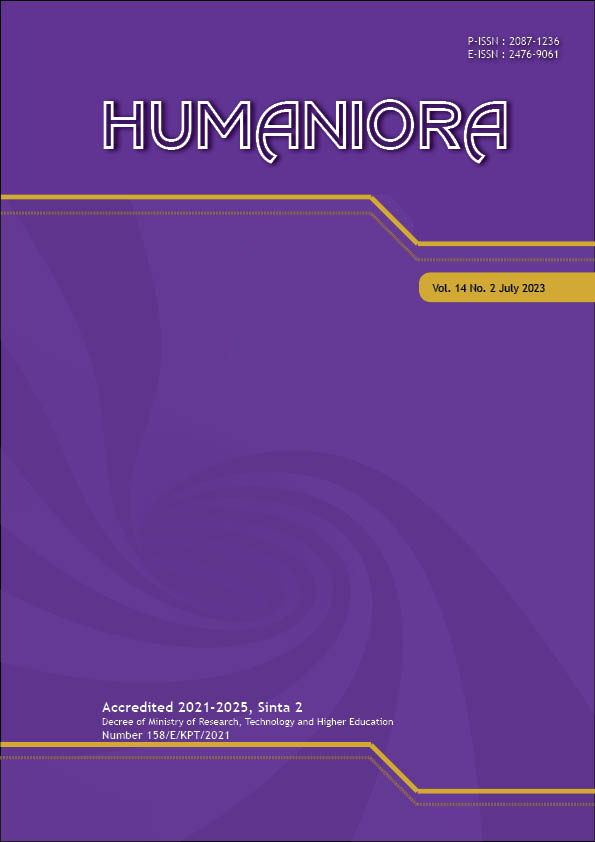The Dependence of Javanese Culture in Chinese Temple Ceremony
DOI:
https://doi.org/10.21512/humaniora.v14i2.8861Keywords:
cultural dependence, Javanese culture, China temple ceremonyAbstract
The research discussed the dependence on local culture, in this case, on Javanese culture, in the Chinese temple ceremony. A close relationship between Chinese and Javanese culture could be seen in the cultural interactions between the Chinese and Javanese. This cultural interaction was related to the relationship of the Chinese people with the Javanese cultural values and cultural elements, such as in the ceremony. In cultural interaction, Chinese people were immersed in the values and elements of Javanese culture. Cultural reality had shown, in historical reality, that the Chinese in the past had met, fused, and merged into Java. The research method applied the research was a qualitative descriptive method and case study with an ethnographic approach. This research shows cultural borrowing and dependence on Javanese culture. One of the dependencies of Javanese culture in Chinese culture is ceremony or ritual. Taking the case of the god's birthday ceremony, which is held in temples in Central Java, namely Tek Hay Bio (Semarang) and Welahan, it will be shown that Javanese culture influences Chinese culture. Consequently, the borrowing and dependence on Javanese culture in Chinese culture cause the dominance of Javanese culture in Chinese temple ceremonies and make the loss of some elements of Chinese culture itself (displacement).
References
D’Orsi, L., & Dei, F. (2018). What is a rite? Émile Durkheim, a hundred years later. Open Information Science, 2(1), 115-126. https://doi.org/10.1515/opis-2018-0009.
Darheni, N. (2018). The language characteristic and its acculturation from Chinese speakers in Losari, Cirebon regency, West Java: The acculturation of Chinese with Javanese culture. KnE Social Sciences, 3(9), 663-686. https://doi.org/10.18502/kss.v3i9.2731
Groeneveldt, W. P. (1960). Historical notes on Indonesia and Malaya, compiled from Chinese sources. Retrieved from https://copac.jisc.ac.uk/search?subject=Chinese Malay Peninsula.&rn=6.
Ives, C. D., & Kidwell, J. (2019). Religion and social values for sustainability. Sustainability Science, 14(5), 1355-1362. https://doi.org/10.1007/s11625-019-00657-0.
Kepirianto, C., Mariam, S., & Purnomo, V. F. (2021). Food offering culture at Chinese rituals in Semarang Chinatown coastal community. E3S Web of Conferences, 317, 01028. https://doi.org/10.1051/e3sconf/202131701028.
Lukman, C. C., Setyoningrum, Y., & Rismantojo, S. (2018). Indonesian Chinese visual language of ‘Qilin’ on Lasem Batik ancestral altar cloth (Tok Wi). Journal of Arts & Humanities, 7(9), 84-94. http://dx.doi.org/10.18533/journal.v7i9.1488.
Mamahit, F. Y. (2021). Abangan Muslims, Javanese worldview, and Muslim–Christian relations in Indonesia. Transformation, 38(1), 31-45. https://doi.org/10.1177/0265378820965602.
McGranahan, C. (2018). Ethnography beyond method: The importance of an ethnographic sensibility. Sites: A Journal of Social Anthropology and Cultural Studies, 15(1), 1-10. https://doi.org/10.11157/sites-id373.
Parker-Jenkins, M. (2018). Problematising ethnography and case study: Reflections on using ethnographic techniques and researcher positioning. Ethnography and Education, 13(1), 18-33. https://doi.org/10.1080/17457823.2016.1253028.
Rudyansjah, T. (2018). Ambivalence of the contemporary world and intricate happiness: The case of two societies in Eastern Indonesia for review only.
Rustopo. (2007). Menjadi Jawa: Orang-Orang Tionghoa dan Kebudayaan Jawa, 1895-1998. Yogyakarta: Ombak.
Wang, Y. (2020). Java in discord: Unofficial history, vernacular fiction, and the discourse of imperial identity in late Ming China (1574-1620). Positions, 27(4), 623-652. https://doi.org/10.1215/10679847-7726916.
Wekke, I. S., Aghsari, D., Evizariza, E., Junaidi, J., & Harun, N. (2018). Religion and culture encounters in Misool Raja Ampat: Marine ritual practice of Sasi Laut. IOP Conference Series: Earth and Environmental Science, 156(1), 012039. https://doi.org/10.1088/1755-1315/156/1/012039.
Widayat, R. (2022). Dragon ornaments in the contexts of Batik cloth, and the cultures of Javanese and Tionghoa in Indonesia. Mudra: Jurnal Seni Budaya, 37(3), 319-338. https://doi.org/10.31091/mudra.v37i3.2017.
Widyatwati, K., Dienaputra, R. D., Suganda, D., & Mamun, T. N. (2021). The teachings of character in local wisdom study on Labuhan Alit Parangkusumo rituals. Review of International Geographical Education Online, 11(3), 527-535. https://doi.org/10.33403/rigeo.800517.
Wijayanti, R. (2021). The influence of traditional Javanese architecture in Chinese-style house in Lasem. IOP Conference Series: Earth and Environmental Science, 778(1), 012033. https://doi.org/10.1088/1755-1315/778/1/012033.
Winatian, A., Nafsiah, N., & Novianti, N. (2019). The representation of Chinese characters in Kevin Kwan’s Crazy Rich Asians (2013). Passage, 7(2), 19-31.
Wuryandari, N. W. (2009). Jalur Proto globalisasi Cina - Jawa: Membaca ulang sumner klasik Cina. In Prosiding the 5th International Conference on Indonesian Studies: “Ethnicity and Globalizationâ€. pp. 184-193.
Yusanto, Y. (2020). Ragam pendekatan penelitian kualitatif. Journal of Scientific Communication (JSC), 1(1), 1-13. https://doi.org/10.31506/jsc.v1i1.7764.
Downloads
Published
How to Cite
Issue
Section
License
Copyright (c) 2023 Celerina Dewi Hartati

This work is licensed under a Creative Commons Attribution-ShareAlike 4.0 International License.
Authors who publish with this journal agree to the following terms:
a. Authors retain copyright and grant the journal right of first publication with the work simultaneously licensed under a Creative Commons Attribution License - Share Alike that allows others to share the work with an acknowledgment of the work's authorship and initial publication in this journal.
b. Authors are able to enter into separate, additional contractual arrangements for the non-exclusive distribution of the journal's published version of the work (e.g., post it to an institutional repository or publish it in a book), with an acknowledgment of its initial publication in this journal.
c. Authors are permitted and encouraged to post their work online (e.g., in institutional repositories or on their website) prior to and during the submission process, as it can lead to productive exchanges, as well as earlier and greater citation of published work.
USER RIGHTS
All articles published Open Access will be immediately and permanently free for everyone to read and download. We are continuously working with our author communities to select the best choice of license options, currently being defined for this journal as follows: Creative Commons Attribution-Share Alike (CC BY-SA)




















